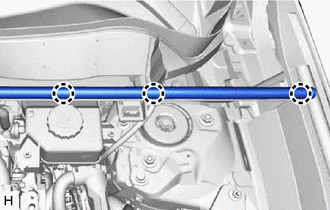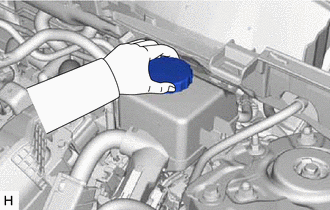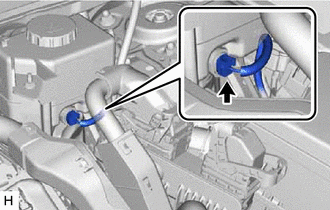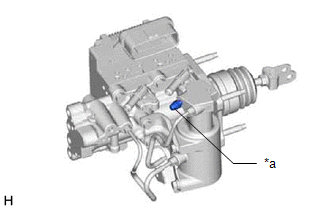| Last Modified: 01-30-2024 | 6.11:8.1.0 | Doc ID: RM100000001G0PK |
| Model Year Start: 2019 | Model: RAV4 | Prod Date Range: [11/2018 - 12/2021] |
| Title: BRAKE SYSTEM (OTHER): BRAKE FLUID (w/o Vacuum Brake Booster): BLEEDING; 2019 - 2021 MY RAV4 RAV4 HV [11/2018 - 12/2021] | ||
BLEEDING
CAUTION / NOTICE / HINT
CAUTION:
The Techstream must be used for air bleeding. If not used, the air bleeding will be incomplete, which is hazardous and may lead to an accident.
NOTICE:
- Perform air bleeding with park (P) selected and the parking brake applied.
- As brake fluid may overflow when bleeding, do not place the fluid can on the reservoir filler opening.
- Perform air bleeding while maintaining the brake fluid level between the MAX and MIN lines on the brake fluid reservoir.
-
Air bleeding will be difficult if the following occurs:
- The brake actuator hose (the hose between the brake booster pump assembly and brake master cylinder reservoir assembly) is higher than the fluid level and air enters the hose.
- During the air bleeding procedure, air enters the brake booster pump assembly while the pump motor is operating.
- While performing air bleeding, the accumulator pressure drop may cause a buzzer to sound. As there is no problem, continue with air bleeding.
- During air bleeding, DTCs for pressure sensor malfunctions, etc. may be stored. After air bleeding and if instructed in the procedures, clear the DTCs.
- Release the parking brake while the linear valve offset calibration procedure.
- Do not allow brake fluid on any painted vehicle body surface. If brake fluid leaks onto any painted surface, immediately wash it off.
-
When bleeding air, select the suitable procedure according to the table below.
Replaced/Installed Item
Work Procedure
Flexible hose (front/rear)
Bleed brake line
Disc brake cylinder assembly (front/rear)
Brake booster pump assembly
Bleed brake system
Brake booster with master cylinder assembly
Brake master cylinder reservoir assembly
PROCEDURE
1. BLEED BRAKE LINE
(a) Remove the center cowl top ventilator louver.
|
(1) Disengage the 3 hooks and separate the hood to cowl top seal from the cowl top ventilator louver sub-assembly. |
|
|
(2) Disengage the 2 claws and 2 guides to remove the center cowl top ventilator louver from the cowl top ventilator louver sub-assembly. |
|
(b) Fill the reservoir with brake fluid.
|
(1) Remove the brake master cylinder reservoir filler cap assembly. |
|
(2) Add brake fluid to the reservoir until the fluid level is between the MAX and MIN lines on the brake fluid reservoir.
Brake Fluid:
SAE J1703 or FMVSS No. 116 DOT3 or SAE J1704 or FMVSS No. 116 DOT4
(c) Bleed the brake line.
(1) Connect the Techstream to the DLC3 and turn the power switch on (IG).
(2) Turn the Techstream on and enter the following menus: Chassis / ABS/VSC/TRAC / Air Bleeding.
Chassis > ABS/VSC/TRAC > Utility
|
Tester Display |
|---|
|
Air Bleeding |
(3) Select "Usual air bleeding", and bleed air from the brake fluid following the instructions on the Techstream.
(4) After air bleeding, tighten each bleeder plug.
Torque:
8.3 N·m {85 kgf·cm, 73 in·lbf}
(5) Clear the DTCs.
(6) Turn the Techstream off and turn the power switch off.
(d) Inspect for brake fluid leaks.
(e) Install the brake master cylinder reservoir filler cap.
(f) Install the center cowl top ventilator louver.
(1) Engage the 2 claws and 2 guides to install the center cowl top ventilator louver from the cowl top ventilator louver sub-assembly.
(2) Engage the 3 hooks and install the hood to cowl top seal from the cowl top ventilator louver sub-assembly.
2. BLEED BRAKE SYSTEM
(a) Remove the windshield wiper motor and link assembly.
(b) Remove the cowl ventilator panel sub-assembly.
|
(c) Wait for at least 2 minutes with the power switch off, and disconnect the reservoir level switch connector. NOTICE: Do not depress the brake pedal or open/close the doors until the reservoir level switch connector is disconnected. HINT: This procedure is not required if the reservoir level switch connector has been disconnected. |
|
(d) Fill the reservoir with brake fluid.
|
(1) Remove the brake master cylinder reservoir filler cap assembly. |
|
(2) Add brake fluid to the reservoir until the fluid level is between the MAX and MIN lines on the brake fluid reservoir.
Brake Fluid:
SAE J1703 or FMVSS No. 116 DOT3 or SAE J1704 or FMVSS No. 116 DOT4
(e) Bleed the brake system.
(1) Connect the Techstream to the DLC3 and turn the power switch on (IG).
(2) Turn the Techstream on and enter the following menus: Chassis / ABS/VSC/TRAC / Air Bleeding.
Chassis > ABS/VSC/TRAC > Utility
|
Tester Display |
|---|
|
Air Bleeding |
(3) Select "ABS actuator has been replaced", and bleed air from brake fluid following the instructions on the Techstream.
NOTICE:
Before following the instructions on the Techstream to perform linear valve offset calibration, release the parking brake. When calibration is complete, immediately apply the parking brake.
|
(4) After air bleeding, tighten each bleeder plug. Torque: Front Bleeder Plug : 8.3 N·m {85 kgf·cm, 73 in·lbf} Rear Bleeder Plug : 8.3 N·m {85 kgf·cm, 73 in·lbf} Stroke Simulator Bleeder Plug : 8.5 N·m {87 kgf·cm, 75 in·lbf} HINT: The stroke simulator bleeder plug is positioned as shown in the illustration. |
|
(5) Clear the DTCs.
(6) Turn the Techstream off and turn the power switch off.
(f) Install the brake master cylinder reservoir filler cap.
(g) Connect the reservoir level switch connector.
(h) Inspect for brake fluid leaks.
(i) Install the cowl ventilator panel sub-assembly.
(j) Install the windshield wiper motor and link assembly.
|
|
|



![2019 MY RAV4 RAV4 HV [11/2018 - 02/2019]; BRAKE CONTROL / DYNAMIC CONTROL SYSTEMS: ELECTRONICALLY CONTROLLED BRAKE SYSTEM (w/o Vacuum Brake Booster): DTC CHECK / CLEAR](/t3Portal/stylegraphics/info.gif)

